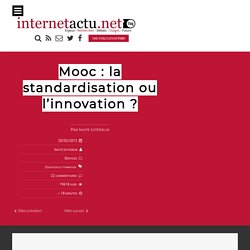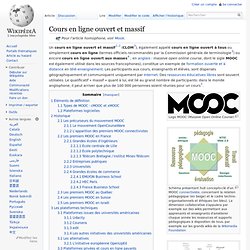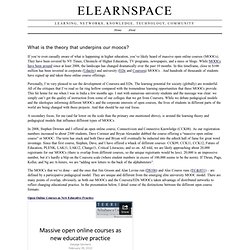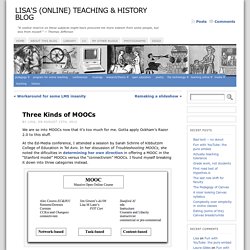

Mooc : la standardisation ou l’innovation. Le développement des cours en ligne massifs et ouverts (Mooc pour massive online open courses) attise autant l’enthousiasme que le rejet.

Pourtant, comme nous l’avons déjà signalé, ils n’ont rien de magique et paraissent bien souvent plus une réponse économique qu’éducative. En accentuant la concurrence entre universités et entre les étudiants eux-mêmes… les Mooc semblent répondre à un problème pédagogique par une solution économique très spécifique. Or, l’enjeu éducatif n’est pas là. C’est ce que nous explique dans cette tribune Dominique Boullier, professeur de sociologie à Sciences Po, coordinateur scientifique du MediaLab et directeur exécutif du projet d’innovation pédagogique Forccast.
Le projet des Mooc consiste à standardiser l’apprentissage. La course à la plate-forme Image : Day of the Mooc par Michael Branson. La frénésie est donc à son comble. L’innovation pédagogique en question En réalité, il leur est aisé de montrer que tout a changé. L'enfer c'est les autres. MOOC mécanique, MOOC connectiviste « Tritypa. Cours en ligne ouvert et massif. Un article de Wikipédia, l'encyclopédie libre.

Pour l’article homophone, voir Mook. Un cours en ligne ouvert et massif[1],[2] (CLOM[3]), également appelé cours en ligne ouvert à tous ou simplement cours en ligne (termes officiels recommandés par la Commission générale de terminologie[3]) ou encore cours en ligne ouvert aux masses[4] ; en anglais : massive open online course, dont le sigle MOOC est également utilisé dans les sources francophones), constitue un exemple de formation ouverte et à distance en télé-enseignement.
Les participants aux cours, enseignants et élèves, sont dispersés géographiquement et communiquent uniquement par Internet. Des ressources éducatives libres sont souvent utilisées. Le qualificatif « massif » quant à lui, est lié au grand nombre de participants: dans le monde anglophone, il peut arriver que plus de 100 000 personnes soient réunies pour un cours[5].
Moocs, de nouvelles formes de cours ouverts. What is the theory that underpins <em>our</em> moocs? If you’re even casually aware of what is happening in higher education, you’ve likely heard of massive open online courses (MOOCs).

They have been covered by NY Times, Chronicle of Higher Education, TV programs, newspapers, and a mess or blogs. While MOOCs have been around since at least 2008, the landscape has changed dramatically over the past 10 months. In this timeframe, close to $100 million has been invested in corporate (Udacity) and university (EDx and Coursera) MOOCs . And hundreds of thousands of students have signed up and taken these online course offerings. Personally, I’m very pleased to see the development of Coursera and EDx. A secondary focus, for me (and far lower on the scale than the primary one mentioned above), is around the learning theory and pedagogical models that influence different types of MOOCs. In 2008, Stephen Downes and I offered an open online course, Connectivism and Connective Knowledge (CCK08). What is the theory that underpins our MOOCs? 1. 2. 3. 4. What is a MOOC? What are the different types of MOOC? xMOOCs and cMOOCs.
The acronym “MOOC” has been in vogue recently, with lots of discussion about organisations like udacity, coursera and edX.

The acronym stands for “Massive Open Online Course.” These organisations provide one interpretation of the MOOC model. They focus on concise, targeted video content – with short videos rather than full-length lectures to wade through – and use automated testing to check students’ understanding as they work through the content. These MOOCS have been dubbed “xMOOCs”. Whilst they include discussion forums, and allow people to bounce ideas around and discuss learning together, the centre of the course is the instructor-guided lesson. I’ve taken and completed a couple of xMOOCS so far.
I’ve found the video lectures to be an improvement on the traditional lecture format. But, of course, the one-on-one interaction and easy back-and-forth questioning that can happen at the end of a formal lecture cannot take place in an xMOOC. Like this: Like Loading... Three Kinds of MOOCs « Lisa. By Lisa, on August 15th, 2012 We are so into MOOCs now that it’s too much for me.

Gotta apply Ockham’s Razor 2.0 to this stuff. At the Ed-Media conference, I attended a session by Sarah Schrire of Kibbutzim College of Education in Tel Aviv. In her discussion of Troubleshooting MOOCs, she noted the dificulties in determining her own direction in offering a MOOC in the “Stanford model” MOOCs versus the “connectivism” MOOCs. I found myself breaking it down into three categories instead. Each type of MOOC has all three elements (networks, tasks and content), but each has a goal that is dominant. Network-based MOOCs are the original MOOCs, taught by Alec Couros, George Siemens, Stephen Downes, Dave Cormier.
Task-based MOOCs emphasize skills in the sense that they ask the learner to complete certain types of work.